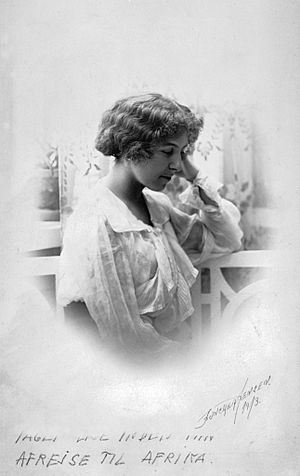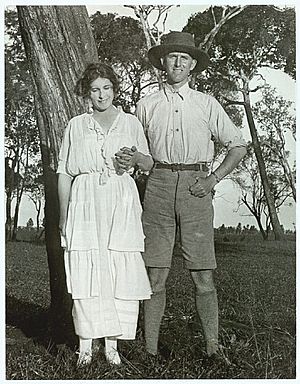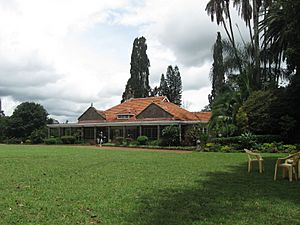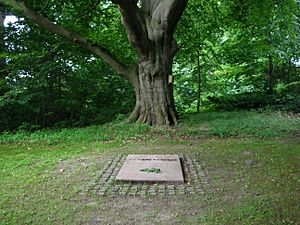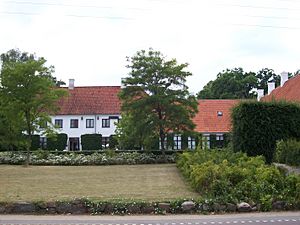Karen Blixen facts for kids
Quick facts for kids
Karen Blixen
|
|
|---|---|
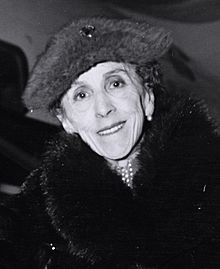
Blixen in 1957
|
|
| Born | Karen Christenze Dinesen 17 April 1885 Rungsted, Zealand, Denmark |
| Died | 7 September 1962 (aged 77) Rungsted, Zealand, Denmark |
| Pen name | Isak Dinesen, Tania Blixen |
| Occupation | Writer |
| Language | English, Danish |
| Notable works | Out of Africa, Seven Gothic Tales, Shadows on the Grass, Babette's Feast |
| Spouse |
Bror von Blixen-Finecke
(m. 1914; div. 1925) |
| Partner | Denys Finch Hatton |
| Relatives | Ellen Dahl (sister) Thomas Dinesen (brother) Andreas Nicolai Hansen (great-grandfather) Mary Westenholz (aunt) |
Baroness Karen Christenze von Blixen-Finecke (born Dinesen; 17 April 1885 – 7 September 1962) was a Danish author who wrote works in Danish and English. She is also known under her pen names Isak Dinesen, used in English-speaking countries, Tania Blixen, used in German-speaking countries, Osceola, and Pierre Andrézel.
Blixen is best known for Out of Africa, an account of her life while living in Kenya, and for one of her stories, Babette's Feast, both of which have been adapted into Academy Award–winning motion pictures. She is also noted, particularly in Denmark, for her Seven Gothic Tales. Among her later stories are Winter’s Tales (1942), Last Tales (1957), Anecdotes of Destiny (1958) and Ehrengard (1963).
Blixen was considered several times for the Nobel Prize in Literature, but it wasn't awarded because judges were reportedly concerned about showing favoritism to Scandinavian writers, according to Danish reports.
Contents
Biography
Early life and education
Karen Dinesen was born in the manor house of Rungstedlund, north of Copenhagen. Her father, Wilhelm Dinesen (1845–1895), was a writer and army officer, including in the 1864 war by Denmark against Prussia and who also joined the French army against Prussia and wrote about the Paris Commune. He was from a wealthy family of Jutland landowners closely connected to the monarchy, the established church and conservative politics. He was elected as Member of Parliament. Her mother, Ingeborg Westenholz (1856–1939), came from a wealthy Unitarian bourgeois merchant family of ship owners. Karen Dinesen was the second oldest in a family of three sisters and two brothers. Her younger brother, Thomas Dinesen, grew up to earn the Victoria Cross in the First World War. Karen was known to her friends as "Tanne".
Dinesen's early years were strongly influenced by her father's relaxed manner and his love of the outdoor life and hunting. He also wrote throughout his life and his memoir, Boganis Jagtbreve (Letters from the Hunt) became a minor classic in Danish literature. From August 1872 to December 1873, Wilhelm had lived among the Chippewa Indians in Wisconsin, where he fathered a daughter. He died on 28 March 1895 when Karen was nine years old.
Karen Dinesen's life at Rungstedlund changed significantly after her father's death. From the age of 10 years, her life was dominated by her Westenholz family. Unlike her brothers, who attended school, she was educated at home by her maternal grandmother and by her aunt, Mary B. Westenholz, who brought her up in the staunch Unitarian tradition. Aunt Bess, as Westenholz was known to Dinesen, had a significant impact on her niece. They engaged in lively discussions and correspondence on women's rights and relationships between men and women.
During her early years, she spent part of her time at her mother's family home, the Mattrup seat farm near Horsens, while in later years there were visits to Folehavegård, an estate near Hørsholm that had belonged to her father's family. Longing for the freedom she had enjoyed when her father was alive, she was able to find some satisfaction in telling her younger sister Ellen hair-raising good-night stories, partly inspired by Danish folk tales and Icelandic sagas. In 1905, these led to her Grjotgard Ålvesøn og Aud in which her literary talent began to emerge. Around this time, she also published fiction in Danish periodicals under the pseudonym Osceola, the name of her father's dog, which she had often walked in her father's company.
In 1898, Karen and her two sisters spent a year in Switzerland, where she learned to speak French. In 1902, she attended Charlotte Sode's art school in Copenhagen before continuing her studies at the Royal Danish Academy of Fine Arts under Viggo Johansen from 1903 to 1906. In her mid-twenties, she also visited Paris, London and Rome on study trips.
While still young, Dinesen spent many of her holidays with her paternal cousin's family, the Blixen-Fineckes, in Skåne in the south of Sweden. She first fell in love with the dashing equestrian baron Hans, but he did not reciprocate. She therefore decided to accept the favours of his twin brother, Baron Bror Blixen-Finecke, and they announced their engagement on 23 December 1912, to the family's surprise. Given the difficulties both were experiencing in settling in Denmark, the family suggested they should move abroad. Their common uncle, Aage Westenholz (1859–1935) who had made a fortune in Siam, suggested they should go to Kenya to start a coffee farm. He and his sister Ingeborg Dinesen invested 150,000 Danish crowns in the venture. Early in 1913, Bror left for Kenya. He was followed by his fiancée in December.
Life in Kenya, 1914–1931
Soon after Dinesen arrived in Kenya, which at the time was part of British East Africa, she and Blixen were married in Mombasa on 14 January 1914. After her marriage, she became known as Baroness Blixen, and she used the title until her then ex-husband remarried in 1929. Bror had attended agricultural college at Alnarp, and then managed the Stjetneholm farm, within the Nasbyholm estate. During her early years, Karen spent part of her time at her mother's family home, the Mattrup seat farm near Horsens. Karen and Bror planned to raise cattle on their farm, but eventually they became convinced that coffee would be more profitable. The Karen Coffee Company was established by their uncle, Aage Westerholz, who chose the name after his daughter Karen, Blixen's cousin, rather than to create an association with Karen Blixen. The couple soon established their first farm, Mbagathi, in the Great Lakes area.
During First World War fighting between the Germans and the British in East Africa, Bror served in Lord Delamere's patrols along Kenya's border with German-Tanganyika and Karen helped transport supplies. The war led to a shortage of workers and supplies. Nevertheless, in 1916, the Karen Coffee Company purchased a larger farm, Mbogani, near the Ngong Hills to the south–west of Nairobi. The property covered 6,000 acres (2,400 ha) of land: 600 acres (240 ha) were used for a coffee plantation, 3,400 acres (1,400 ha) were used by the natives for grazing, and 2,000 acres (810 ha) of virgin forest were left untouched.
The land was not well-suited for coffee cultivation, given its high elevation. The couple hired local workers: most were Kikuyu who lived on the farmlands at the time of the couple's arrival, but there were also Wakamba, Kavirondo, Swahili and Masai. Initially, Bror worked the farm, but it soon became evident that he had little interest in it and preferred to leave running the farm to Blixen while he went on safari. For the first time, English became the language she used daily.
At her farm, she also used to take care of local sick persons, including those suffering from fever, variola, meningitis and typhus.
She returned to Denmark in June 1915.
On 5 April 1918, Bror and Karen were introduced at the Muthaiga Club to the English big game hunter Denys Finch Hatton (1887–1931). Soon afterwards he was assigned to military service in Egypt.
By 1919, the marriage had run into difficulties, causing her husband to request a divorce in 1920. Bror was dismissed as the farm manager by their uncle, Aage Westenholz, chair of the Karen Coffee Company, and Karen took over its management in 1921.
On his return to Kenya after the Armistice, Hatton developed a close friendship with Karen and Bror. He left Africa again in 1920.
Against her wishes, Bror and Karen separated in 1921.
Hatton often travelled back and forth between Africa and England, and visited Karen occasionally. He returned in 1922, investing in a land development company. After her separation from her husband she and Finch Hatton had developed a close friendship, which eventually became a long-term love affair. In a letter to her brother Thomas in 1924, she wrote: "I believe that for all time and eternity I am bound to Denys, to love the ground he walks upon, to be happy beyond words when he is here, and to suffer worse than death many times when he leaves..." But other letters in her collections show that the relationship was unstable, and that Karen's increasing dependence upon Finch Hatton, who was intensely independent, was an issue.
Karen and Bror were officially divorced in 1925. Karen would go to Government House where she had befriended Joan Grigg who was the bored wife of the governor. Grigg would in time create a charity to create hospitals in Kenya.
Finch Hatton moved into her house, made Blixen's farmhouse his home base between 1926 and 1931 and began leading safaris for wealthy sportsmen. Among his clients was Edward, Prince of Wales. On safari with his clients, he died in the crash of his de Havilland Gipsy Moth biplane in March 1931. Blixen recorded their parting.
"When he had started in his car for the aerodrome in Nairobi, and had turned down the drive, he came back to look for a volume of poems, that he had given to me and now wanted on his journey. He stood with one foot on the running-board of the car, and a finger in the book, reading out to me a poem we had been discussing.
‘Here are your grey geese,’ he said.
I saw grey geese flying over the flatlands
Wild geese vibrant in the high air –
Unswerving from horizon to horizon
With their soul stiffened out in their throats –
And the grey whiteness of them ribboning the enormous skies
And the spokes of the sun over the crumpled hills.
Then he drove away for good, waving his arm to me."
At the same time, the failure of the coffee plantation, as a result of mismanagement, the height of the farm, drought and the falling price of coffee caused by the worldwide economic depression, forced Blixen to abandon her estate. The family corporation sold the land to a residential developer, and Blixen returned to Denmark in August 1931 to live with her mother. In the Second World War, she helped Jews escape out of German-occupied Denmark. She remained in Rungstedlund for the rest of her life.
Life as a writer
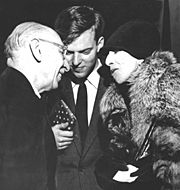
While still in Kenya, Blixen had written to her brother Thomas, "I have begun to do what we brothers and sisters do when we don't know what else to resort to, I have started to write a book. ... I have been writing in English because I thought it would be more profitable." Upon returning to Denmark, aged 46, she continued writing in earnest. Though her first book, Seven Gothic Tales, was completed in 1933, she had difficulty finding a publisher and used her brother's contacts with Dorothy Canfield to help. The book was published in the United States in 1934 under the pseudonym Isak Dinesen, though the publisher refused to give Blixen an advance and discouraged the use of a pseudonym. When it was chosen as a Book-of-the-Month Club selection, sales skyrocketed. This first book, highly enigmatic and more metaphoric than Gothic, won wide recognition in the United States, and publication of the book in the United Kingdom and Denmark followed, though with difficulty. Unable to find a translator she was satisfied with, Blixen prepared the Danish versions herself, though they are not translations, but rather versions of the stories with differing details. Blixen's explanation for the difference was that she "very much wanted it to be published in Danish as an original Danish book, and not in any — no matter how good — translation". The Danish critics were not enthusiastic about the book and were annoyed, according to Blixen, that it had first been published abroad. Blixen never again published a book in English first. All her later books were either published first in Danish, or published simultaneously in Danish and English.
Her second book, now the best known of her works, Out of Africa, was published in 1937. Its success firmly established her reputation. Having learned from her previous experience, Blixen published the book first in Denmark and the United Kingdom, and then in the United States. Garnering another Book-of-the-Month Club choice, Blixen was assured of not only sales for this new work, but also renewed interest in Seven Gothic Tales. She was awarded the Tagea Brandt Rejselegat (a Danish prize for women in the arts or academic life) in 1939. The work brought attention from critics who were concerned not only with literary appraisal of the book, but also with defining Blixen's intentions and morality. Post-colonial criticism has linked her with contemporary British writers and in some cases branded her as just another morally bankrupt white European aristocrat. Danish scholars have not typically made judgments about her morality, perhaps understanding that while elements of racism and colonial prejudices, given the context and era, are inherent in the work, her position as an outsider, a Dane and a woman made evaluating her, rather than the work, more complex. Some critics, including Carolyn Martin Shaw and Raoul Granqvist, have judged her to be a racist and a white supremacist, while other critics, such as Abdul R. JanMohamed, have recognized both her romanticized colonial attitudes and her understanding of colonial problems, as well as her concern and respect for African nationalists.
Five years after the publication of Out of Africa, Blixen published a collection of short stories called Winter's Tales (1942; Danish: Vinter-eventyr). A departure from her previous Gothic works, the stories reflect the starkness of the times, occupation tinged with courage and pride, and hope for the future. The stories do not reflect resistance, but resilience, and explore the interdependence of opposites. She examines shame versus pride in "The Heroine", cowardice and courage in "The Pearls", master and servant in "The Invincible Slave-Owners", and life versus death as well as freedom versus imprisonment in "Peter and Rosa". Because of the war, she had to be creative about getting the manuscript published, travelling to Stockholm and meeting with employees at both the American and British embassies. The Americans were unable to ship personal items, but the British embassy agreed, shipping the document to her publisher in the United States. Blixen did not receive further communication about Winter's Tales until after the war ended, when she received correspondence praising the stories from American troops who had read them in the Armed Services Editions during the conflict.
Blixen worked on a novel she called Albondocani for many years, hoping to produce a volume in the style of Les Hommes de bonne volonté by Jules Romains, with interwoven stories across several volumes. The main character, Harun al-Rashid, was taken from One Thousand and One Nights. She worked on several collections at once, categorizing them according to their themes and whether she thought they were mostly to make money or literary. She jumped between writing the collections of stories for Albondocani to Anecdotes of Destiny to New Gothic Tales and New Winter's Tales. Almost all of Blixen's tales from the 1940s and 1950s follow a traditional style of storytelling, weaving Gothic themes with myth and bewitchment as a means of exploring identity, morality and philosophy. Most also take place against the background of the 19th century or earlier periods. Concerning her deliberately old-fashioned style, Blixen mentioned in several interviews that she wanted to express a spirit that no longer existed in modern times, one of being rather than doing. Her narratives hover between skillfully crafted illusion and romanticism, with a keen knowledge of the preferred tastes of her audience. Blixen crafted her English tales in a more direct manner and her Danish tales in a 19th-century writing style which she felt would appeal more to them. Because she simultaneously worked on different collections, works written in this period were not published until almost a decade after they were originally written.
During World War II, when Denmark was occupied by the Germans, Blixen started her only full-length novel, the introspective tale The Angelic Avengers, under a French pseudonym, Pierre Andrezel, for the first and last time. Though it was written in Danish, she claimed that it was a translation of a French work written between the wars and denied being its author. The book was published in 1944 and nominated for a third Book-of-the-Month Club selection. Blixen initially did not want the book to be nominated, but eventually accepted the distinction. The horrors experienced by the young heroines have been interpreted as an allegory of Nazism, though Blixen also denied that interpretation, claiming instead that the novel was a distraction that had helped her to escape the feeling of being imprisoned by the war. In 1956, in an interview for The Paris Review, she finally acknowledged that she was the author of the novel, saying that it was her "illegitimate child". Dorothy Canfield described "The Angelic Avengers" in her Book-of-the-Month Club News review as "of superlatively fine literary quality, written with distinction in an exquisite style".
A collection of stories, Last Tales (Danish: Sidste fortællinger) was published in 1957, followed in 1958 by the collection Anecdotes of Destiny (Danish: Skæbne-Anekdoter). Last Tales included seven stories that Blixen had intended to be parts of Albondocani. It also included sections called New Gothic Tales and New Winter's Tales. Blixen's concept of the art of the story is perhaps most directly expressed in the stories "The Blank Page" and "The Cardinal's First Tale" in Last Tales. These tales feature many innuendos, which Blixen employed to force her reader into participating in the creation of the story. She mixed obscure references with explicit observation. Her writing was not just a retelling of tales, however; it was a complex layering of clues and double entendres which force the reader to deduce Blixen's intent and draw conclusions. The story, for Blixen, was vital to expression: it gives a recitation of experience, and simultaneously a potential vision of the possible.
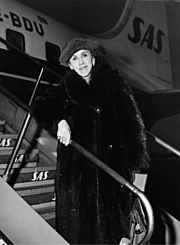
Blixen planned for Anecdotes of Destiny to be a final part of the Last Tales in 1953, but as she prepared all the stories, she decided to publish Anecdotes as a separate volume. She wanted both books to appear simultaneously, but because of publication issues Anecdotes was delayed for another year. The most famous tale from Anecdotes is "Babette's Feast", about a chef who spends her entire 10,000-franc lottery prize to prepare a final spectacular gourmet meal. The story evaluates relationships and examines whether the austere but charitable life led by the sisters, in adherence to an ideal, is less true to faith than the passionate gift from the heart of their housekeeper. The story was reproduced in a film directed and written by Gabriel Axel, which was released in 1987, and won the Best Foreign Film Oscar in 1988.
In 1959, Blixen made her only trip to the United States. It was an extended trip spanning from January to April, and while the purpose was to complete a series of educational films and discussions for the Ford Foundation and Encyclopædia Britannica, Blixen intended to enjoy herself. She was the feature of a Life Magazine article in the edition of 19 January 1959 and attended two Broadway openings. Feted by the well-to-do of New York society, Blixen was invited to dine with socialites Babe Paley and Gloria Vanderbilt. She was photographed by Richard Avedon and Cecil Beaton; the guest of John Steinbeck, who hosted a cocktail party in her honor; and serenaded by Maria Callas. Nobel laureate Pearl Buck and poets e. e. cummings and Marianne Moore came to see her, as well. When Blixen expressed a desire to meet Marilyn Monroe, the author Carson McCullers arranged a meeting with Monroe and her husband, the playwright Arthur Miller. Throughout the trip, Blixen played upon her crafted persona as a reclusive aristocrat and an outsider, but also that of an eccentric, who would eat only oysters and grapes, and drink only champagne. It was clear that she was ill, as it was reported that she was "frail" and "weighed 63 pounds [28 kg]" and she spent part of her time receiving "intravenous infusions".
After returning to Denmark, Blixen resumed working, despite severe illness, finishing the African sketches Shadows on the Grass in 1960. The last of her works published during her lifetime, it was awarded her fifth selection as a Book-of-the-Month. A return-to-Africa memoir, Shadows explores the stereotypes and labels of Europeans and Africans, concluding that "prejudices reveal more about the perceiver than the perceived". The book consists of four tales: "Shadows on the Grass", which focuses on her Somali servant Farah; "Faith is Revealed", which relays the importance of symbolism; "The Great Gesture", which depicts medical issues in her community; and "Echoes from the Hills", which evaluates her loneliness after leaving Africa and the tireless vigil her staff from Africa kept on her former home for many years.
Death
Blixen died in 1962 at Rungstedlund, her family's estate, at the age of 77.
Posthumous works
Among Blixen's posthumously published works are: Ehrengard (1962), Carnival: Entertainments and Posthumous Tales (1977), Daguerreotypes, and Other Essays (1979) and Letters from Africa, 1914–31 (1981). In the late 1960s, Orson Welles planned an anthology of Dinesen's films, in which he intended to release "The Heroine", "The Deluge at Norderney", "A Country Tale", and "Full Moon". After a day of shooting film in Budapest on "The Heroine", the project was canceled because his financier went bankrupt. The Immortal Story was adapted to film in 1968 by Welles and released simultaneously on French television and in theaters. Welles later attempted to film The Dreamers, but only a few scenes were ever completed. In 1982, Emidio Greco directed an Italian film, Ehrengard, based upon Blixen's work of the same name, which was not released until 2002 due to financial complications.
Legacy
Awards and honors
For her literary accomplishments, Blixen was awarded the Danish Holberg Medal in 1949, the Ingenio et Arti medal in 1952 , granted the inaugural Hans Christian Andersen Scholarship of the Danish Writers Association in 1955 and received the Henrik Pontoppidan Memorial Foundation Grant in 1959. Peter Englund, permanent secretary of the Swedish Academy, described it as "a mistake" that Blixen was not awarded the Nobel Prize in Literature during the 1930s and when Hemingway won the prize in 1954, he stated that Bernard Berenson, Carl Sandburg and Blixen deserved the prize more than he did. Although never awarded the prize, she finished in third place behind Graham Greene in 1961, the year Ivo Andrić was awarded the prize. In 2012, the Nobel records were opened after 50 years and it was revealed that Blixen was among a shortlist of authors considered for the 1962 Nobel Prize in Literature, along with John Steinbeck (the eventual winner), Robert Graves, Lawrence Durrell, and Jean Anouilh. Blixen became ineligible after dying in September of that year.
Blixen's former secretary and house manager, Clara Svendsen wrote a book, Notes about Karen Blixen (Danish: Notater om Karen Blixen) in 1974, which told of the transformation of the young woman who moved to Africa into the sophisticated writer. Giving personal anecdotes about Blixen's life, Svendsen focused on the private woman behind her public image. Blixen's great-nephew, Anders Westenholz, an accomplished writer himself, wrote two books about her and her works: Kraftens horn: myte og virkelighed i Karen Blixens liv (1982) (translated into English as The Power of Aries: myth and reality in Karen Blixen's life and republished in 1987) and Den glemte abe: mand og kvinde hos Karen Blixen (1985) (The Forgotten Ape: man and woman in Karen Blixen).
Karen Blixen's portrait was featured on the front of the Danish 50-krone banknote, 1997 series, from 7 May 1999 to 25 August 2005. She also featured on Danish postage stamps that were issued in 1980 and 1996. The Asteroid 3318 Blixen was named in her honor on her 100th birthday.
On 17 April 2010, Google celebrated her 125th birthday with a Google Doodle.
Rungstedlund Museum
Blixen lived most of her life at the family estate Rungstedlund, which was acquired by her father in 1879. The property is located in Rungsted, 24 kilometres (15 mi) north of Copenhagen, Denmark's capital. The oldest parts of the estate date to 1680, and it had been operated as both an inn and a farm. Most of Blixen's writing was done in Ewald's Room, named after author Johannes Ewald.
In the 1940s, Blixen contemplated selling the estate due to the costs of running it, but the house became a haven for a group of young intellectuals, including Thorkild Bjørnvig, Frank Jæger, Erling Schroeder, among others, who found the house as intriguing as its occupant. They began using the property as a literary salon, which continued to be used by artists until 1991. Bjørnvig, who edited the journal Heretica also developed a close friendship with Blixen. The house was repaired and restored between 1958 and 1960 with a portion of the estate set aside as a bird sanctuary. After its restoration, the property was deeded to the Danish Literary Academy and became managed by the Rungstedlund Foundation, founded by Blixen and her siblings. It was opened to the public as a museum in 1991. In 2013 The Karen Blixen Museum joined the Nordic museum portal.
Karen Blixen Museum, Nairobi
When Blixen returned to Denmark in 1931, she sold her property to a developer, Remi Martin, who divided the land into 20 acres (8.1 ha) parcels. The Nairobi suburb that emerged on the land where Blixen farmed coffee is now named Karen. Blixen herself declared in her later writings that "the residential district of Karen" was "named after me". The family corporation that owned Blixen's farm was incorporated as the "Karen Coffee Company" and the house she lived in was built by the chairman of the board, Aage Westenholz, her uncle. Though Westenholz named the coffee company after his own daughter Karen and not Blixen, the developer of the suburb named the district after its famous author/farmer rather than the name of her company.
Changing hands several times, the original farmhouse occupied by Blixen was purchased by the Danish government and given to the Kenyan government in 1964 as an independence gift. The government established a college of nutrition on the site and then when the film Out of Africa was made in 1985, the college was acquired by the National Museums of Kenya. A year later, the Karen Blixen Museum was opened and features many of Blixen's furnishings, which were reacquired from Lady McMillan, who had purchased them when Blixen left Africa. The museum house has been judged a significant cultural landmark, not only for its association with Blixen, but as a cultural representative of Kenya's European settlement, as well as a significant architectural style—the late 19th-century bungalow.
Works
A considerable proportion of the Karen Blixen archive at the Royal Danish Library consists of the unpublished poems, plays and short stories Karen Dinesen wrote before she married and left for Africa. In her teens and early 20s, she probably spent much of her spare time practising the art of writing. It was only when she was 22 that she decided to publish some of her short stories in literary journals, adopting the pen name Osceola.
Some of these works were published posthumously, including tales previously removed from earlier collections and essays she wrote for various occasions.
- Eneboerne (The Hermits), August 1907, published in Danish in Tilskueren under the pen name Osceola)
- Pløjeren (The Ploughman), October 1907, published in Danish in Gads danske Magasin, under the name Osceola)
- Familien de Cats (The de Cats Family), January 1909, published in Danish in Tilskueren under the name Osceola)
- Sandhedens hævn – En marionetkomedie, May 1926, published in Danish in Tilskueren, under the name of Karen Blixen-Finecke; an English translation by Donald Hannah titled The Revenge of Truth: A Marionette Comedy was published in Performing Arts Journal in 1986
- Seven Gothic Tales (1934 in the United States, 1935 in Denmark)
- Out of Africa (1937 in Denmark and England, 1938 in the United States)
- Winter's Tales (1942)
- The Angelic Avengers (1946)
- Last Tales (1957)
- Anecdotes of Destiny (1958) (including Babette's Feast)
- Shadows on the Grass (1960 in England and Denmark, 1961 in the United States)
- Ehrengard (posthumous 1963, United States)
- Carnival: Entertainments and Posthumous Tales (posthumous 1977, United States)
- Daguerreotypes and Other Essays (posthumous 1979, England and United States)
- On Modern Marriage and Other Observations (posthumous 1986, United States)
- Letters from Africa, 1914–1931 (posthumous 1981, United States)
- Karen Blixen in Danmark: Breve 1931–1962 (posthumous 1996, Denmark)
- Karen Blixen i Afrika. En brevsamling, 1914–31 i IV bind (posthumous 2013, Denmark)
See also
 In Spanish: Karen Blixen para niños
In Spanish: Karen Blixen para niños



